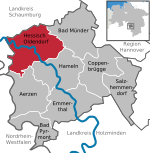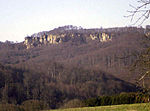Fischbeck Abbey

Fischbeck Abbey (German: Stift Fischbeck) is a convent for canonesses in Fischbeck near Hessisch Oldendorf, Lower Saxony, Germany. It was founded in 955 by the noblewoman Helmburgis, a relation of the powerful family of the Ecbertiner, on land that had been given to her for the purpose by King Otto I, and is still a house of canonesses today, although now Lutheran women's convent rather than a Roman Catholic monastery. Despite later repairs and refurbishments, the cloisters and the church, built mostly in the 12th and 13th centuries, are still basically Romanesque. In the abbey church is a tapestry made in 1583, which portrays the foundation of the abbey in six panels. In the 1950s the author Manfred Hausmann was inspired by the tapestry to write the dramatic piece "Der Fischbecker Wandteppich" (The Tapestry of Fischbeck), which has been performed in the abbey church at Fischbeck several times.
Excerpt from the Wikipedia article Fischbeck Abbey (License: CC BY-SA 3.0, Authors, Images).Fischbeck Abbey
Helmburgisplatz,
Geographical coordinates (GPS) Address External links Nearby Places Show on map
Geographical coordinates (GPS)
| Latitude | Longitude |
|---|---|
| N 52.141944444444 ° | E 9.2972222222222 ° |
Address
Stift Fischbeck
Helmburgisplatz
31840
Lower Saxony, Germany
Open on Google Maps










